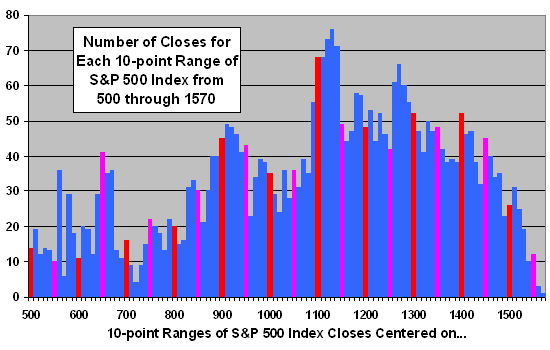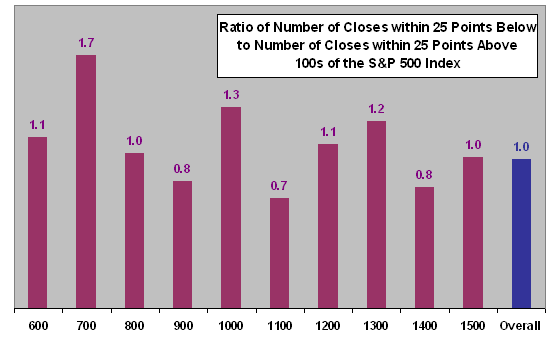There is a fair amount of research on clustering of prices for individual stocks and other assets near round numbers. (For examples, search the Social Science Research Network for “price clustering”.) Do closing levels of the S&P 500 Index tend to cluster near round numbers? To investigate, we count the number of daily closes for adjacent 10-point ranges of the S&P 500 Index from one centered on 500 to one centered on 1570. The first range in the sample is therefore 495-505 and the last is 1565-1575. Using all closes of the index above 495 (roughly since 1995), we find that:
The following chart is a histogram of daily closes of the S&P 500 Index within adjacent 10-point ranges across the entire sample. Red columns center on round 100s, and pink columns center on round 50s. Visual inspection does not indicate systematic clustering near these round numbers. In other words, in the context of nearby ranges, 50s and 100s of the S&P 500 Index do not stand out as “high-gravity.”
Note that using point ranges rather than percentage ranges may skew counting, because a 10-point range at 500 is twice as large percentage-wise as a 10-point range at 1000 (yet there are more closes around high numbers than low numbers). Also, the S&P 500 Index is not done visiting some (or all) of these ranges.
It appears that the variation in range frequencies is much more related to occurrence of bull and bear markets and high and low volatility regimes than any psychological attraction of round numbers.
Do round number act systematically more like support than resistance?

The next chart shows the ratio of number of closes within 25 points below to number of closes within 25 points above round 100s of the S&P 500 Index from 600 through 1500. It also shows the combined ratio for all ten of these round numbers. Ratios for specific 100s are sometimes above and sometimes below 1.0, and the overall ratio is 1.0. There is no consistent tendency for closing levels to cluster either below or above 100s. In other words, 100s do not consistently act more like support than resistance, or vice versa.

In summary, evidence from simple tests on the S&P 500 Index since the mid-1990s does not support a belief that closing levels of the market gravitate toward round numbers. Nor do they support a belief that round numbers of the index systematically act like either support or resistance.